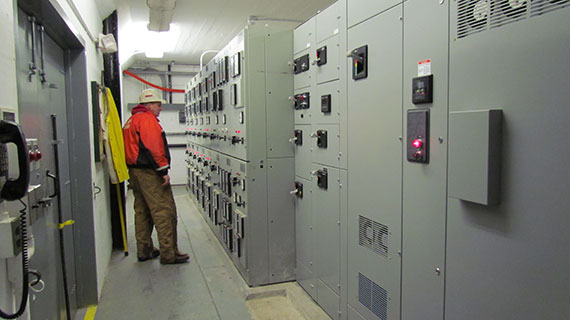Nachrichten
Designing an AC-DC Converter Circuit
Autor: ZYG Leistungsmodul Time: 2023-5-7
AC-DC converter circuits are essential components in many electronic devices such as power supplies and battery chargers. These circuits allow the conversion of AC power from the electrical grid to DC power that can be used to power electronic devices. In this article, we will discuss the design of an AC-DC converter circuit.
The first step in designing an AC-DC converter circuit is to determine the input voltage and the desired output voltage. Once these values are known, the next step is to choose the appropriate transformer and rectifier components.
The transformer is used to step down the input voltage to a level that is suitable for the rectifier circuit. The rectifier circuit is responsible for converting the AC voltage to DC voltage. There are two main types of rectifiers: half-wave and full-wave. The choice of rectifier depends on the specific application and the desired output voltage.
After selecting the appropriate transformer and rectifier components, the next step is to choose the smoothing capacitor. The smoothing capacitor is used to filter out any ripple in the DC voltage. The value of the capacitor depends on the output voltage and the load current.

Once the smoothing capacitor is chosen, the next step is to select the output voltage regulator. The regulator is used to regulate the output voltage to a constant level despite changes in the input voltage or load current. There are several types of voltage regulators, including linear regulators and switching regulators. The choice of regulator depends on the specific application and the desired level of efficiency.
After selecting the voltage regulator, the final step is to choose the output filter. The output filter is used to filter out any remaining high-frequency noise that may be present in the output voltage. The output filter typically consists of a capacitor and an inductor.
In summary, designing an AC-DC converter circuit involves selecting the appropriate transformer, rectifier, smoothing capacitor, voltage regulator, and output filter. The specific components chosen depend on the input and output voltage requirements, the desired level of efficiency, and the specific application.
Vorherige: AC-DC Converter Module: Converting Alternating Current to Direct Current
Nächste: Efficient Industrial AC-DC Converter for Reliable Power Conversion
relevante Information
-
2023-6-30
Introducing the DM Series DC DC Power Supply
In today's fast-paced technological era, where electronic devices play an integral role in our daily lives, the need for reliable and efficient power supply solutions has become more critical than ever. Recognizing this demand, we are proud to introduce the DM Series DC-DC Power Supply – a cutting-edge power supply unit that offers unrivaled performance, versatility, and reliability. The DM Series DC-DC Power Supply is designed to meet the power requirements of a wide range of electronic applications, including industrial equipment, telecommunications devices, medical devices, and automotive electronics. With its advanced features and robust construction, it has quickly become the go-to choice for engineers and manufacturers around the world. One of the key features of the DM Series is its...
Einzelheiten anzeigen -
2023-5-5
Designing an AC-DC Converter Circuit
Introduction An AC-DC converter circuit is a device that converts an alternating current (AC) source to a direct current (DC) source. This conversion is important because many electronic devices require a DC power source to operate. Designing an AC-DC Converter Circuit The first step in designing an AC-DC converter circuit is to determine the specifications of the circuit. This includes the input voltage range, the output voltage and current requirements, and the efficiency of the circuit. Next, the type of AC-DC converter circuit to be used must be chosen. There are several types of AC-DC converter circuits including half-wave rectifiers, full-wave rectifiers, and bridge rectifiers. Each type has its advantages and disadvantages, so the choice depends on the specific application....
Einzelheiten anzeigen -
2023-4-18
AC-DC-Wandler: Umwandlung von Wechselstrom in Gleichstrom
An AC-DC converter is an electronic device that converts Alternating Current (AC) to Direct Current (DC). The conversion process involves rectifying AC voltage and filtering it to produce a smooth DC output. The converter operates using a combination of electronic components that work together to produce the desired output. The process of converting AC to DC involves several stages. First, the AC voltage is rectified using diodes to produce a pulsating DC voltage. The pulsating DC voltage is then filtered to produce a smooth DC output. The filtering process involves using capacitors and inductors to remove unwanted ripple and noise from the DC voltage. There are different types of AC-DC converters, including half-wave rectifiers, full-wave rectifiers, and bridge rectifiers. Half-wave...
Einzelheiten anzeigen -
2023-4-23
wie man ac zu dc stromversorgung verdrahtet
When it comes to converting alternating current (AC) to direct current (DC), there are several steps involved in the process. While it may seem complicated, with the right tools and some basic knowledge of electrical wiring, it is actually quite simple. In this article, we will provide a step-by-step guide on how to wire AC to DC power supply. Step 1: Choose the right power supply Before you begin the wiring process, it is important to choose the right power supply for your needs. You will need to consider factors such as the input voltage (AC), output voltage (DC), and current rating. Make sure that the power supply you select matches the requirements of the device or circuit you will...
Einzelheiten anzeigen -
2023-5-26
DC Power Conversion: Understanding the Basics and Applications
Direct current (DC) power conversion is an essential process in our modern world. It involves the transformation of electrical energy from one form to another. DC power conversion is widely used in various areas, from household appliances to industrial automation, and from renewable energy generation to electric vehicles. In this article, we will discuss the basics of DC power conversion and its applications. DC Power Conversion Basics DC power conversion involves three main components: input source, conversion circuit, and output load. The input source can be an AC power source, a battery, or a renewable energy source like solar or wind. The conversion circuit is responsible for converting the input power to the desired output power. It consists of voltage...
Einzelheiten anzeigen -
2023-4-20
So bauen Sie ein 120-Volt-Wechselstromnetzteil für einen 3-Volt-Gleichstromausgang
Wenn Sie ein kleines Gerät mit Strom versorgen möchten, das 3 Volt Gleichstrom benötigt, fragen Sie sich vielleicht, wie Sie ein geeignetes Netzteil bauen können. Eine Möglichkeit besteht darin, ein eigenes 120-Volt-Wechselstromnetzteil zu bauen und einen Spannungsregler zu verwenden, um die Spannung auf 3 Volt herunterzuregeln. Hier, wie es geht: Materialien: - Abwärtstransformator (120 V AC bis 12 V AC) - Brückengleichrichter - Kondensator - Spannungsregler (LM317) - Kühlkörper - Widerstände - Potentiometer - LED - 3-Volt-DC-Last - Lötkolben und Lötzinn - Multimeter Schritt 1: Auswahl eines Transformators Der erste Schritt ist die Auswahl eines Abwärtstransformators, der den 120-V-Wechselstromeingang in einen 12-V-Wechselstromausgang umwandelt. Machen...
Einzelheiten anzeigen


















